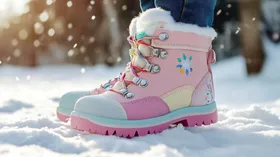What Causes Babies’ Feet to Turn Red?
Explore potential risks causing the bottom of your baby's feet to turn red along with effective treatment options
Updated December 3, 2024.

Have you ever noticed the bottom of your baby's feet looking a bit flushed? It's a normal part of their development, but understanding the potential causes can help you stay informed and ensure your little one's feet stay healthy and comfortable.
Normal Causes of Red Feet in Babies
Before worrying about your baby's red feet, consider these typical and generally harmless reasons behind this common phenomenon
Temperature Changes
A sudden temperature change is one of the most common reasons for a baby's feet to turn red. When a baby moves from a cold environment to a warm one, blood vessels in their feet dilate, causing a red appearance.
Extreme temperatures—like cold, heat, and humidity—can affect your baby's delicate skin more severely. Its thinness makes it more sensitive to these temperature changes, potentially leading to heat rash. To prevent this:
- Keep your baby's skin well moisturised
- Dress them in the right gear for the weather
- Shield them from direct sunlight
- Use baby-friendly sunscreen for protection when necessary
Circulation Development
Newborns and young infants are still developing their circulatory systems. So, blood flow to their extremities can be inconsistent, leading to temporary redness or even a blotchy appearance on their feet.
Restricted blood circulation can also cause a baby's feet to turn red. This can happen due to:
- Tight clothing
- Ill-fitting shoes
- Tight stockings
Tip: Use loose-fitting socks made from natural fabrics to help your baby's feet breathe to avoid chafing.
Activity and Pressure
As babies become more mobile, increased activity can cause their feet to turn red due to increased blood flow. Similarly, if a baby has been lying or sitting in one position for a while, the pressure on its feet can cause temporary redness. This should change back to normal quickly once the baby changes position or the pressure is relieved.
Skin Conditions and Irritations
The following skin conditions and irritations can also cause a baby's feet to turn red:
- Diaper Rash: Although it mainly affects the diaper area, diaper rash can occasionally spread to the rest of the body, like the feet.
- Contact Dermatitis: This condition develops when a baby touches certain chemicals like lotions, detergents, and fragrances.
- Eczema: Atopic dermatitis—or infantile eczema—can result in red, itchy, and irritated skin.
When to Seek Medical Attention
While red feet are often harmless, there are some situations where you should consult a paediatrician:
- If the redness is accompanied by swelling, warmth, or seems painful to your baby
- If there's a rash that doesn't go away or spreads to other parts of the body
- If your baby develops a fever along with red feet
- If the redness persists for an extended period or happens frequently
- If you notice blisters, discharge, or other unusual symptoms
Putting Your Baby's Comfort First
Red feet in babies are usually harmless, but they can cause discomfort and indicate something needs to change. Understanding the causes is the first step, but taking action is crucial.
Quick fixes like breathable socks and gentle moisturisers are helpful, but for comprehensive care, consider First Walkers. They keep red feet at bay with superior ventilation and a chafe-free interior. Plus, their adaptable design means less frequent replacements—saving you time and money.
So, give yourself peace of mind, knowing you're providing the best for your baby's developing feet.
Related Products:
Disclaimer: First Walkers' information is intended for educational and informational purposes related to toddler footwear and feet. We encourage you to consider individual circumstances and consult qualified orthopaedists about specific conditions.
Related Articles

10 Best High Top Shoes for Boys for Ankle Stability and Strength
Bhashwati Deb Barma
December 5, 2024

7 Best Closed-Toe Sandals for Boys: Active Play Choices
Benjamin Aduwo
September 29, 2023

Essential Guide to Finding Shoes for Kids with Sensory Issues
Jasrah Javed
January 29, 2025

10 Best Boots for Your Baby Girl's Winter Wardrobe
Babafemi Adebajo
December 6, 2024

Orthopaedic Shoes for Toddlers
First Walkers AUS
April 10, 2024
Related Posts
Babafemi Adebajo
Do You Need a Prescription for Orthopaedic Shoes?
Babafemi Adebajo
Why Do My Toddler’s Feet Look Yellow?
Jonathan Coom
Should You Pop Your Child's Foot Blisters?
Babafemi Adebajo
How to Help Dyspraxic Kids Tie Their Shoes?
Ruchita Dhavade
Are My Baby’s Feet Swollen or Fat?
Bhashwati Deb Barma
Dealing With Shoe Allergies in Children: What to Look For
Babafemi Adebajo